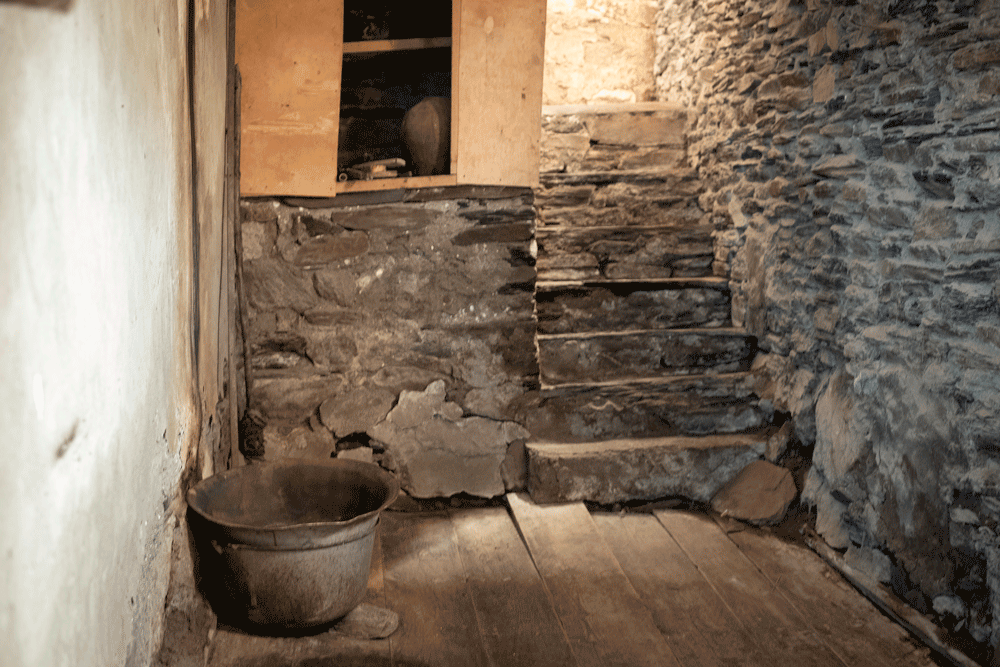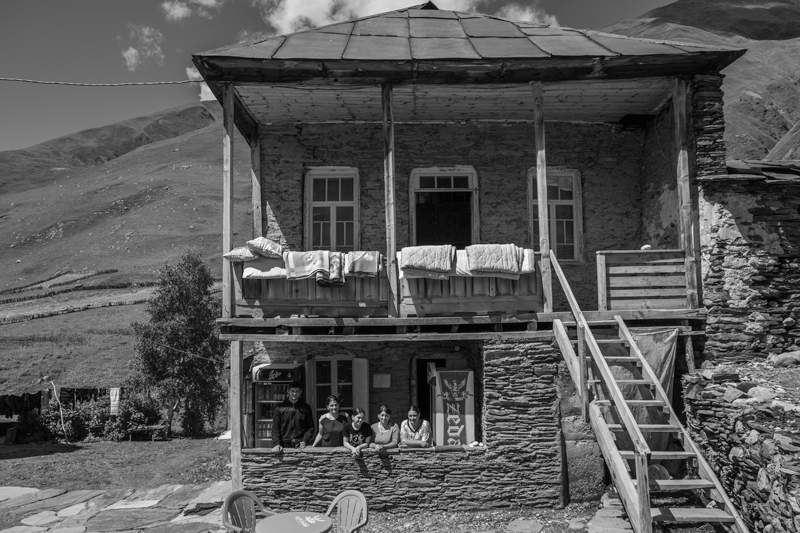The article series "Svaneti Series" (distributed via Twitter @doinggeography) provides insights and analyses of the histoircal region of Svaneti in Georgia social life from a geographical viewpoint. This means that all articles examine the social space and the practices taking place within it. This includes both the built space and the non-built space and all communications about places and spaces. The series of articles addresses English speaking tourists who visit Svaneti and are interested in more information about the culture, ecology and economic conditions in the region. The article series is distributed via Twitter, see @doinggeography.
The architectural landscape of Svaneti is characterised by decaying buildings
For many visitors to Svaneti they are part of the overwhelming charm of the mountain landscape. They give the impressive mountain world a morbid charm. For some tourists, however, the decaying buildings in Upper Svaneti are also a sign that the Svaneti people do not like to take care of their cultural heritage.

For many Svans, however, the landscapes of ruins represent the worst experience they have had in their lives. Experiences that have deeply traumatized entire family lines and still have an impact on the families‘ lives today. Many Svans have not yet come to terms with the events of the winter of 1986/87.
In the winter of 1986/87, the Western Caucasus and North Caucasus were affected by heavy snowfalls. Entire villages were buried in the mountains. Snow thicknesses of up to five metres were reached, traffic routes and power lines were interrupted. After the first snowfalls, about 1500 people were evacuated from the high mountain region of Svaneti. In the village community of Mulachi there were 400 families with their many relatives in the first phase. Within the second wave of snowfalls, the villages above Mestia, such as Tsvirmi, were more severely affected.
Already in the second half of December, heavy snowfalls had begun in large parts of the Western Caucasus, causing the snow cover in the Lentechi region to rise to over 200 cm. Initially, road traffic was severely affected, and finally, by January, snow levels on the upper course of the rivers had increased two to three times as much as usual. Rain and snowfall decreased slightly for only a short period of time. In the course of the day, temperatures rose above zero, increasing the danger of avalanches. The second phase of the natural disaster swept across western and central Georgia. The influx of wet air masses from the Black Sea region and their rise in the Caucasus triggered very heavy precipitation at the end of January 1987. The geographical focus of the disaster had now shifted to the lowlands, where 200 km of the lower reaches of the Rioni, 180 km of the Chobi and 150 km of the Ketilari were flooded. At the same time, the persistent snowfall in the mountains led to snow heights of over 5 m. Many dead were therefore to be reported. In addition, houses, agricultural land and livestock were damaged, and roads and supply lines were interrupted.
For more historical photos go to https://stefanapplisphotography.wordpress.com/2020/07/30/the-winter-catastrophy-of-1986-87-in-svaneti/


1987 publication on the effects of the „forces of nature“ on the people of Svaneti
About 1200 people were evacuated from there. The damage was so extensive that the affected families were permanently settled in the southeast of Georgia as early as the beginning of February 1987. In total, the State resettled about half of the population of Svaneti.
As an outside visitor, it is difficult to imagine what the resettlement may have meant to the people. Until today the identity of the inhabitants of Svaneti is strongly bound to the space and the line of ancestry. The following is also unique for a Europe shaped by migratory movements: Whoever lives today in Svaneti in a building or on a piece of land whose use can be traced back to the early Middle Ages knows that all the people who ever lived there were related to him.
For more historical photos go to https://stefanapplisphotography.wordpress.com/2020/07/30/the-winter-catastrophy-of-1986-87-in-svaneti/
Today many Svans return from the resettlement areas in Kvemo Kartli. On the one hand, they hope to earn money in tourism by repairing their family buildings. On the other hand, for most of them this often means to return home, at least for a while. With often very little money they try to renovate the rooms they had to leave as a child. They come across many memorabilia. Because often the houses were locked since 1987. Most of the furnishings in these buildings date from the 1940s and 1950s. If the roof has been preserved, it is often like entering a museum.






Text: © Stefan Applis (2020)
Photographs: © Stefan Applis (2018, 2019)

My Song teacher sent me the link to the interesting article, thank you for sharing, now looking forward to read more. Kind regards from Austria, Rosemarie Fodrasz
LikeLike
That’s very kind of you. Thank you very much. I would be pleased if you would distribute the articles – Svanetie needs more information for tourists, for more understanding of the region! 🙂 https://twitter.com/doinggeography Warmest regards, Stefan.
LikeLike